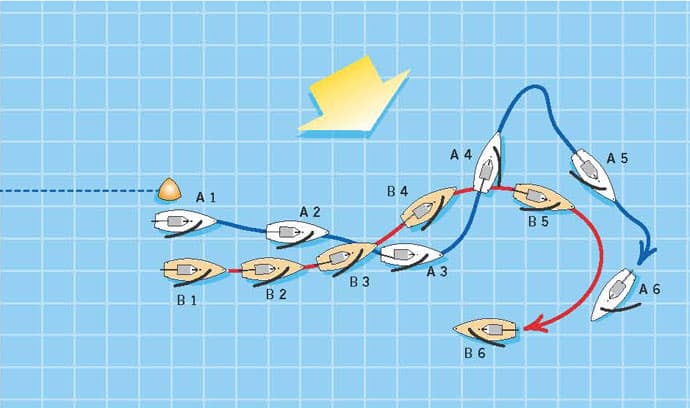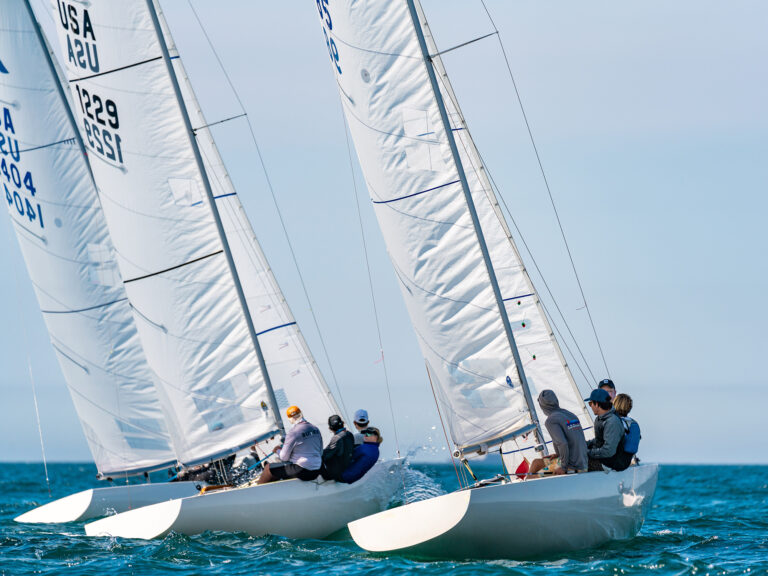Some of my all-time favorite races were the final race of a series in which my boat and one other were the only two that could still mathematically win the series. In those races, in addition to the usual concerns with boatspeed, wind, current, and fleet tactics, I had to devise additional match-racing tactics to ensure that, at the finish, we’d have the points necessary to win.
My goal this month is to give you a guide to all the rule interpretations dealing with the situations that come up in what I call the “end game”—a race, usually the last race of a series, in which two boats match race each other within a fleet race. Of course, this is no normal match race. There may be 10, 50, or even 100 other boats in the fleet, all with their normal rights and obligations, and the usual rules for match racing (Appendix C in the rulebook) do not apply.

(Above: At positions 2 and 5, B is the right-of-way boat and permitted to use her right of way to block A from jibing. Between positions 3 and 4 Rule 16.1 does not apply to B and, therefore, she may change course to block A from tacking. Illustration by Kim Downing.)
If you find yourself in such a close series with, say, Joe, you must know the series scores for you and Joe, and the scores for any throw outs for each of you. Make sure you have up-to-date scores and that you know all you can about any unresolved protests or requests for redress that might change your score or Joe’s. Work out your winning combinations—i.e., the various positions in which you and Joe could finish that would result in your winning the series. And don’t forget to account for how any tiebreakers might fall.
The most important rule in such a race is Rule 2, Fair Sailing, which states, “A boat . . . shall compete in compliance with recognized principles of sportsmanship and fair play.” The reason that this rule is important is that those so-called “recognized principles” are not widely recognized and agreed upon within the sailing community. As an example, quite a few people think it’s not fair play for you to closely cover an opponent and drive him back in the fleet in a way that allows several boats to pass you both. Given how diverse the views are on Rule 2, it is important to understand the authoritative ISAF interpretations of Rule 2 found in ISAF Cases 34, 52, and 78. Of these, Case 78 is the most important.
You must also keep Rule 23.2 in mind. It states, “Except when sailing her proper course, a boat shall not interfere with a boat . . . sailing on another leg.”
Here are major principles that you can learn from these two rules and the three ISAF cases:
• Case 78 states that it is permissible for you to closely cover Joe on a beat to windward or luff him far off course on a reach or a run provided that (1) you are both on the same leg of the course, (2) you do not break any racing rule, except possibly Rule 2, while maneuvering against Joe, and (3) if protested, you can convince the protest committee that “there was a reasonable chance that your tactic would benefit your series result.” It would probably be difficult to convince the protest committee that these tactics were justified in any race other than the last race of a series because in earlier races it would not yet be established that only you or Joe could win the series.
• You can maneuver in these ways even if slowing Joe allows several boats to pass you both.
• You may use these tactics even if they are not successful—that is, Joe manages to win the series or even pass you while you’re covering or luffing him.
• Case 34 covers an incident in which a boat was over the starting line at the starting signal and knew that she was over. Instead of returning to the pre-course side of the line and starting as required by Rule 28.1, she sailed part of the way back to the line and then closely covered her series opponent, driving him way back in the fleet. The decision in that case states that the boat that did the close covering broke Rule 2, that it would have been appropriate to take action against her under Rule 69 and to have considered disqualifying her from all races of the series. In addition, the boat that was covered and driven back was entitled to redress under Rule 62.1(d).
• Case 52 describes permissible tactics before the start of a race provided they have a reasonable chance of improving your series score. Boat B may drive Boat A so far away from the starting line, as shown in the diagram, that, after B breaks away from A and jibes to return to start, B is virtually assured a much better start than A. Two different tactics are illustrated here. At positions 2 and 5, B uses right of way under Rule 11 to block A from jibing. While using right of way to block A, B must take care that whenever she changes course she gives A room to keep clear as required by Rule 16.1. Between positions 3 and 4, because B is the keep-clear boat (first under Rule 12 and later under Rule 11) Rule 16.1 does not apply when B changes course. Therefore, B’s luff to prevent A from tacking between positions 3 and 4 is permitted.
Many countries, including the United States, now use combined results from several major international regattas as a selection series to pick their Olympic team. For example, Spain might base its Olympic selection for the Laser Class on the results of four major international regattas, with the last of the four being Kiel Week. Spain would announce to its Laser sailors its own special scoring system for its Olympic selection, and, of course, that scoring system would not be included in the Notice of Race or Sailing Instructions for Kiel Week. Suppose that, going into the last race at Kiel, two Spanish Laser sailors, Pedro and Jose, are nearly tied under Spain’s scoring system. Is it permissible for Pedro to use end-game match racing tactics against Jose in that race?
ISAF Cases 34, 52, and 78 do not address this question. However, ISAF has a new service for its race officials that permits, say, an International Judge to ask a question of an ISAF Question and Answer Panel, and the answer will appear on the ISAF website at www.sailing.org/raceofficials/q&a-service.php. The panel’s answers are not authoritative interpretations and explanations of the racing rules, as the ISAF Cases are. Even though those answers have not had the thorough review that ISAF Cases are required to undergo, they are the considered opinions of the panel, all of whom are experienced ISAF Race Officials.
Two recently published ISAF Q&As (A001 and A004) deal with issues that arise when one or more countries is running their Olympic selection within a major regatta, such as Kiel Week. The answers given in these Q&As reinforce the interpretations given in Case 78, but they go further in two important ways:
• The answers define a “series” as an event governed by one Notice of Race and one set of Sailing Instructions. Kiel Week is a “series,” but the Spanish Laser Olympic selection races are not. This means Pedro cannot use the end-game tactics described above if they worsen his standing in Kiel Week. If he did, he would be subject to disqualification under Rule 2, that DSQ score could not be used as his “throw out” (see Rule 90.3(b)), and Jose would be entitled to redress (see Rule 62.1(d)).
• Also, an answer in Q&A A004 singles out one tactic that is always permitted at any time in any race. Pedro can simply follow Jose around the course without interfering with him. That simple strategy might be sufficient to assure Pedro’s selection as a member of Spain’s Olympic team.









